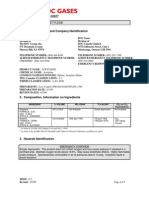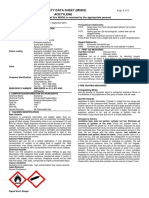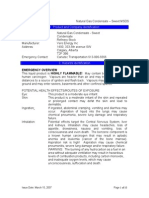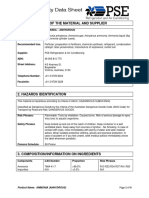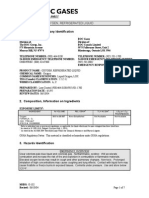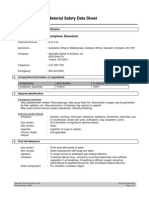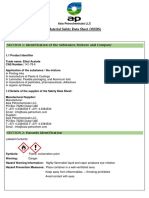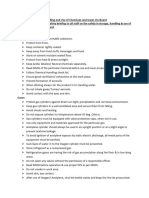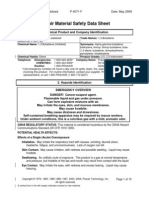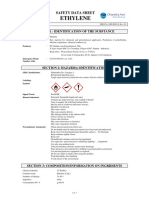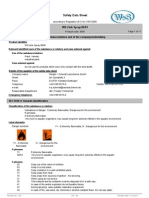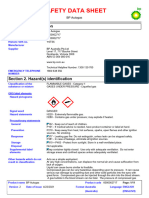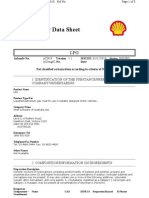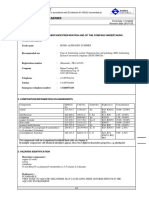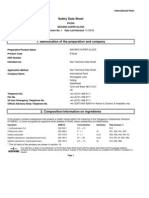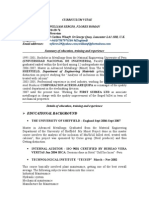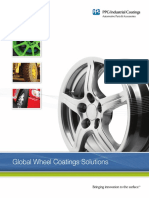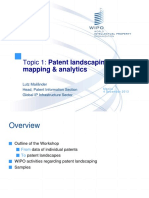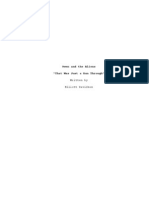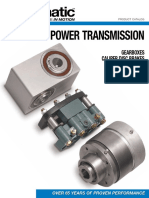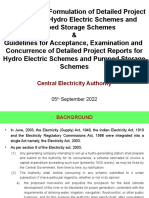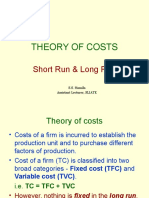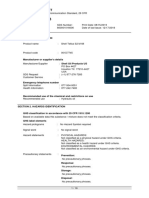AFROX Is A Member of The Linde Group The Stripe Symbol and The Word "AFROX" Group Trademarks. Page 1 of 2
AFROX Is A Member of The Linde Group The Stripe Symbol and The Word "AFROX" Group Trademarks. Page 1 of 2
Uploaded by
Jonie KieCopyright:
Available Formats
AFROX Is A Member of The Linde Group The Stripe Symbol and The Word "AFROX" Group Trademarks. Page 1 of 2
AFROX Is A Member of The Linde Group The Stripe Symbol and The Word "AFROX" Group Trademarks. Page 1 of 2
Uploaded by
Jonie KieOriginal Description:
Original Title
Copyright
Available Formats
Share this document
Did you find this document useful?
Is this content inappropriate?
Copyright:
Available Formats
AFROX Is A Member of The Linde Group The Stripe Symbol and The Word "AFROX" Group Trademarks. Page 1 of 2
AFROX Is A Member of The Linde Group The Stripe Symbol and The Word "AFROX" Group Trademarks. Page 1 of 2
Uploaded by
Jonie KieCopyright:
Available Formats
MATERIAL SAFETY DATA SHEET (MSDS)
ACETYLENE
(Please ensure that this MSDS is received by the appropriate person)
DATE NO.:AUGUST 2011
Version 2
Ref No.: MSO56
1 PRODUCT AND COMPANY IDENTIFICATION
Product identification
Product name
Acetylene
chemical formula
C2H2
Trade name
Ecetylene
Acetylene
Disolved acetylene-DA
Portapak acetylene
Econo pak acetylene
Agrigas acetylene
Instrumentation grade acetylene
Colour coding
Acetylene cylinder have maroon (A01) maroon.
Acetylene cylinder may have different valve guard
colours depending on gas grade-green, orange, blue.
Some grades have the grade stenciled along the body in
white letters. Decals attached to the cylinder also
provide information on grade.
Valves
All large acetylene cylinders have a brass cylinder valve
with a 5/8 inch BSP female left hand outlet thread. Only
the small portapak acetylene cylinder has an 11/16 inch
left hand female thread.
Company identification
African oxygen limited
23 Webber street
Johannesburg
2001
Tel; (011) 490 0400
Fax: (011) 490 0506
Emergency phone number 0860 111185 or 011 873 4382
(24 hours)
2 COMPOSITION /INFORMATION ON INGREDIENTS
Chemical Name
Acetylene
Chemically family
unsaturated hydrocarbon
Synonyms
dissolved acetylene (DA)
CAS No.
74-86-2
UN No
1001
ERG No
116
Hazchem warning
2 A flammable gas
3 HAZARDS IDENTIFICATION
Main hazards.
Acetylene is extremely flammable and slightly lighter
than air. Acetylene ignites easily and burn with an
extremely hot bright flame giving off black smoke.
Flammability limits in air; are between 2.5 and 82% by
volume. Highly explosive mixtures can be formed in air
in this range. Acetylene is dissolved in acetone under
pressure in a steel cylinder. Cylinder are filled with a
porous substance to distribute the acetylene throughout
the cylinder volume. Cylinders are transportable gas
container. Cylinders must never be exposed to heat or
any source of ignition as this may cause cylinder to
rupture and explosion may occur due to the gas involve.
Adverse health effects
Acetylene gas can act as a simple asphyxiate, it may
decrease the concentration of oxygen in the air below the
level to support life. High concentration may cause
narcosis. A 20% concentration may cause dyspnea and
headache. A 40% concentration or more may cause
collapse.
Chemical hazards
Never use free acetylene at pressure above 150Kpa as
the gas may decompose with explosive force under
certain conditions. Acetylene may form readily
explosive acetylide compounds when it come in-contact
with copper, silver or mercury. Acetylene should not be
used with these metals, their salts, compounds or highly
concentrated alloys.
Vopour inhalation
Acetylene is a simple asphyxiate, high concentration
may cause narcosis.
Eye contact
Unknown effect
Skin contact
Unknown effect
Ingestion
Unknown effect
4 FIRST AID MEASURES
Acetylene act as a simple asphyxiant, by reducing the oxygen concentration in the
air below a level where it can support life, Person expose to such condition should be
taken to an uncontaminated area, keep the patient should be keep warm. Apply
artificial respiration only if the patient is not breathing, refrain using month to month
resuscitation. Person who has inhaled the fumes produced in a fire or during
chemical reaction may not show any symptoms immediately. Person who has been
expose the fumes should be encourage recline down and keep still. Prompt medical
attention is mandatory to such person. The person should be kept under medical
observation for at least 48hours. Give the patient treatment if symptoms show.
5 FIRE FIGHTING MEASURES
Extinguishing media
Use dry powder or fog-water spray to extinguish
acetylene flame. In the absence of fog equipment a fine
spray of water may be used.
Specific hazards
Acetylene is highly flammable. Cylinder in naked fire
may cause the activation of the pressure-relief devices,
and/or the unpredictable
violent rupture of the
cylinder, which will add a large quantity of fuel to the
fire. Cylinder must be cool with large quantity of water
at a safe distance. An unignited gas cloud will form a
highly flammable or explosive mixture in air, and all
sources of ignition must be eliminated. A gas cloud may
also act as a simple asphyxiate.
Emergency actions
Acetylene leak, leak not ignited, cylinder not hot.
eliminate all sources of ignition in the area. Close the
cylinder valve. If necessary tighten the gland nut. If leak
continues, evacuate the area and minimizing personal
risk by moving the leaking cylinder to a safe well
ventilated area. Post warning notices and prevent access
to the area. Do not tamper with the safety devices. Hot
cylinder or Acetylene leak ignited. Raise fire alarm.
close cylinder valve if it is safe to do so, and use
appropriate fire extinguisher to put off flame cause by
acetylene. If not possible allow small fires to remain
burning if they are not posing a hazard or impinging on
cylinder, this will prevent build-up pressure from the
cylinders. Call fire brigade. Remove all cylinders from
the path of the fire/flame. Cool cylinders exposed to the
fire by applying large amounts of water from a safe
location. Evacuate the area. Do not attempt to move
cylinders involved in a fire until they are cold for at least
one hour. Check by stopping the cooling process and
note whether the cylinders surface dry rapidly or
generate steam. Continue the cooling process until the
cylinder surface remain wet without any dry patches
forming quickly. Check with a bare hand that cylinders
remain cool for at least 1 hour. Should any cylinders be
found to be warm, repeat the cooling process. If the
cylinders surface no long show rapid dry patches after
stoping the cooling process, immerse the cylinder in
water for 12 hours to prevent spontaneous auto-ignition.
Protective clothing
Fire fighters putting off the flame of acetylene should
wear approved self contained breathing apparatus with
full face mask. Safety gloves and shoes ,or boots,
should be worn when handling cylinders
Environmental
precaution
Acetylene is lighter than air, ensure that it is not trapped
in confined spaces ,otherwise this could lead to the
formation of an oxygen deficient atmosphere. Ventilate
all confined spaces using forced draught if necessary.
Ensure that all electrically equipments are flameproof.
6 ACCIDENTAL RELEASE MEASURES
Personal precautions
Acetylene act as a simple asphyxiant, Care should be taken when entering confined
spaces where leaks may have occurred. Do not enter any potentially hazardous area
with any source of ignition, such as lit cigarette, non-flammaproof torch and cell
phone.
Small spills
Small leaks should be extinguished by shutting off the source of acetylene supply,
e.g. closing the valve on the cylinder, or tightening the gland nut if its possible. If
unable to stop the small leaks the source of acetylene, move the cylinder to a well
AFROX is a member of The Linde Group
The stripe Symbol And the word AFROX Group Trademarks.
Page 1 of 2
MATERIAL SAFETY DATA SHEET (MSDS)
ACETYLENE
(Please ensure that this MSDS is received by the appropriate person)
DATE NO.:AUGUST 2011
Version 2
ventilate area, away from any source of ignition .If the small leak has resulted in a
flame use a multi-purpose dry powder extinguisher. If an extinguish is not available ,
a welders glove or heavy cloth soaked in water may be used to extinguish the flame.
Large spills
Stop the source of acetylene if it can be stop without risk. Eliminate all source of
ignition and static discharges in the area. Restrict access to the area until completion
of the clean-up procedure. Post warnings to prevent people from approaching the
area. Wear adequate protective clothing when working near the source of leak.
Ventilate the area using force draught if necessary. Ensure that all equipment is
flameproof.
7 HANDLING AND STORAGE
Do not allow cylinders to slide or come into contact with sharp edges. Cylinder
should always be transported in the upright position, with the valve uppermost and
be firmly secured to prevent rolling. Use first in-first-out inventory procedure or
system to prevent full cylinder from being stored for excessive periods of time.
Dont store acetylene and oxygen cylinder in a close proximity to each other.
Oxygen and acetylene cylinder should not be stored in a same room because of these
fact: explosives, oxidizing agent, radioactive agent, organic peroxides,
spontaneously combustible material. Cylinders should be stored away from any
source of ignition or excessive heat. If cylinder has been stacked horizontal, stand it
upright for at least 30 minutes before use to prevent acetone carryover. keep out of
reach of children
8 EXPOSURE CONTROLS/PERSONAL PROTECTION
Occupational exposure
Hazards
unknown effect.
Engineering control
measures
engineering control measures are preferred to reduce
exposures. General methods include mechanical
ventilation process or personal enclosure and control of
process conditions. Administrative
controls and
personal protective equipment may also be required. Use
a suitable flameproof ventilation system separate from
other exhaust ventilation systems. When exhausting
direct to outside, supply sufficient replacement air to
make up for air removed by exhaust system.
Personal protection
self-contained breathing apparatus should be worn when
fighting larger fire. Safety goggles, gloves and shoes or
boots should be worn when handling cylinders.
8 PHYSICAL AND CHEMICAL PROPERTIES
Physical data
Chemical symbol
C2H2
Molecular weight
26.038 g/mol
Specific volume @200C and 1 atm
918.0 ml/g
Relative density(air=1)@1atm
1.0904g/ml
Flammability limits in air
2.5-82%(by volume)
Auto-ignition temperature
3050C
Colour
unknown
Taste
unknown
Odour
Ethereal when pure.Garlic
commercial
when
10 STABILITY AND REACTIVITYS
Conditions to avoid
smoking, naked flame or any source of heat should not
be brought near the cylinder storage are. Never use
cylinders as rollers or to support or for any other purpose
other than the storage of acetylene. Never tamper with
pressure relief devices on the cylinder. Keep sparks,
flames or any source of ignition away from the cylinder.
Never test leaks with a flame.
Incompatible materials See section on chemical hazards.
Hazards decomposition
products
Acetylene in its free state under pressure may
decompose violently. The higher the pressure, the
smaller the energy needed to cause an explosion. Never
use free gas outside of the cylinder at a pressure
exceeding 150kpa. Should cylinder content burning
inside, as indicated by a hot cylinder surface, this could
lead to a build-up pressure, resulting in a cylinder
rupture. Refer to section 5 for treating hot cylinder
11 TOXICOLOGICAL INFORMATION
Acute toxicity
No known effect
Skin and eye contact
No known effect
Chronic toxicity
TLV 750 VPM
Carcinogenicity
No known effect
Mutagenicity
No known effect
Reproductive hazards
No known effect
(for further information see section 3.adverse health effects)
12 ECOLOGICAL INFORMATION
As acetylene is lighter than air, it will disperse rapidly in open areas. It does not pose
a hazard to the ecology.
12 ECOLOGICAL CONSIDERATIONS
Disposal methods
Small amounts may be blown to the atmosphere under
controlled conditions. No source of ignition should be in
the vicinity. Large amounts should only be handled by
the gas supplier.
Disposal of packaging
The disposal of cylinders must only be handled by the
gas supplier.
14 TRANSPORT INFORMATION
Road transportation
UN No.
Class
Danger group
Subsidiary risk
ERG No.
Hazchem warning
SEA TRANSPORTATION
IMDG
Class
Label
AIR TRANSPORTATION
ICA/IATA code
Class
Packaging group
Packaging instructions
-cargo
-passenger
Maximum quatity allowed
-cargo
-passenger
1001
2.1
flammable gas
Asphyxiant
116
2 A flammable gas
1001
2.1
flammable gas
1001
2.1
flammable gas
forbidden
forbidden
forbidden
forbidden
15 REGULATORY INFORMATION
EEC Hazard class
flammable gas.
Risk phrases
R2 Risk of explosion by shock, fricyion, fire or other sources
of ignition
R11 highly flammable gas.
R44 risk of explosion if heated under confinement space
Safety phrases
S2 keep out of reach of children
S15 keep away from heat source
S16 keep away from sources of ignition
S33 take precautionary measures against static discharges
S37 wear suitable gloves
S39 wear eye / face protection
S51 use only in well ventilated areas
National legislation None
Refer to SABS 0265 for explanation of the above.
16 OTHER INFORMATION
Bibliography
Compressed gas association, Arlington,Virginia handbook of compressed gases-3rd
edition Matheson. Matheson gas data book-6 th edition SABS 0265-labeling of
dangerous substances
17 EXCLUSION OF LIABILITY
Information contained in this publication is accurate at the date of publication .The
company does not accept liability arising from the use of this information, or the use
,application, adaptation or process of any products described herein.
AFROX is a member of The Linde Group
The stripe Symbol And the word AFROX Group Trademarks.
Page 2 of 2
You might also like
- AcetyleneDocument9 pagesAcetylenegkmlalNo ratings yet
- Safety Data Sheet (MSDS) Acetylene: Please Ensure That This MSDS Is Received by The Appropriate Person)Document3 pagesSafety Data Sheet (MSDS) Acetylene: Please Ensure That This MSDS Is Received by The Appropriate Person)Pasko DaboNo ratings yet
- Acetyline Cylinder PDFDocument2 pagesAcetyline Cylinder PDFniazNo ratings yet
- Acetylene Gas C2H2 Safety Data Sheet SDS P4559Document10 pagesAcetylene Gas C2H2 Safety Data Sheet SDS P4559pranksterboyNo ratings yet
- MSDS Natural Gas Condensate - SweetDocument10 pagesMSDS Natural Gas Condensate - SweetMuhammad Naufal Nazhib KhanNo ratings yet
- MSDS Etilen Oksida 2Document8 pagesMSDS Etilen Oksida 2shekureNo ratings yet
- R717 (Ammonia) - (MSDS)Document9 pagesR717 (Ammonia) - (MSDS)syed sameer mustafaNo ratings yet
- AcetyleneDocument2 pagesAcetyleneuyvukd3No ratings yet
- Propylene: Material Safety Data SheetDocument9 pagesPropylene: Material Safety Data Sheetismaeel247No ratings yet
- Acetylene MsdsDocument9 pagesAcetylene MsdssalcabesNo ratings yet
- Tanque 1500 Gal-TWDocument38 pagesTanque 1500 Gal-TWKarla RodríguezNo ratings yet
- LPG SDSDocument8 pagesLPG SDSkevinNo ratings yet
- Material Safety Data Sheet: Section 1. Chemical Product and Company IdentificationDocument6 pagesMaterial Safety Data Sheet: Section 1. Chemical Product and Company Identificationandy hamonanganNo ratings yet
- Product Name: Oxygen, Refrigerated LiquidDocument7 pagesProduct Name: Oxygen, Refrigerated LiquidHugo AlvarezNo ratings yet
- HSE - Take Care With AcetyleneDocument5 pagesHSE - Take Care With Acetylenesl1828No ratings yet
- Styrene MonomerDocument7 pagesStyrene MonomertayplastNo ratings yet
- Isobutylene C4H8 Safety Data Sheet SDS P4614Document8 pagesIsobutylene C4H8 Safety Data Sheet SDS P4614Wayan PartaNo ratings yet
- SDS GHS 01 EthyleneDocument7 pagesSDS GHS 01 EthylenededehendarsyahNo ratings yet
- Oxygen MSDSDocument7 pagesOxygen MSDSchidanandNo ratings yet
- Liquefied Petroleum Gas (LPG) : 1. Identification of The Material and SupplierDocument6 pagesLiquefied Petroleum Gas (LPG) : 1. Identification of The Material and SupplierstefenandreanNo ratings yet
- Material Safety Data Sheet: Emergency OverviewDocument7 pagesMaterial Safety Data Sheet: Emergency OverviewsahilchemNo ratings yet
- Ms Ds NaphthaDocument12 pagesMs Ds NaphthaCatharina Natasa BellaFortunaNo ratings yet
- AcetyleneDocument6 pagesAcetylenemalimsaidi_160040895No ratings yet
- Safety Data Sheet: Ingredient Einecs Concentration Symbol(s) Risk Phrases ( )Document9 pagesSafety Data Sheet: Ingredient Einecs Concentration Symbol(s) Risk Phrases ( )panagiotis_panagio_2No ratings yet
- Kerosene PDFDocument9 pagesKerosene PDFishnafathonahNo ratings yet
- BTX m60 MsdsDocument10 pagesBTX m60 MsdsAMIT GUPTANo ratings yet
- MSDS GHe AirProductsDocument7 pagesMSDS GHe AirProductsAirGroupGasNo ratings yet
- Material Safety Data Sheet: Section 1. Chemical Product and Company IdentificationDocument6 pagesMaterial Safety Data Sheet: Section 1. Chemical Product and Company IdentificationHenry OdulioNo ratings yet
- Matheson Gas EO SDSDocument8 pagesMatheson Gas EO SDSXiaLUNo ratings yet
- SF6 MSDSDocument7 pagesSF6 MSDSjaycarpioNo ratings yet
- MSDS - NitrogenDocument7 pagesMSDS - NitrogenSatish Kumar MauryaNo ratings yet
- Msds AcetyleneDocument7 pagesMsds AcetyleneSyaifuddin Ma'rufNo ratings yet
- Material Safety Data Sheet: Acetylene, DissolvedDocument4 pagesMaterial Safety Data Sheet: Acetylene, Dissolvedmicaziv4786No ratings yet
- Material Safety Data Sheet (MSDS) : SECTION 1: Identification of The Substance/Mixture and CompanyDocument9 pagesMaterial Safety Data Sheet (MSDS) : SECTION 1: Identification of The Substance/Mixture and CompanyAli BeetleNo ratings yet
- Gas Welding Safety.Document3 pagesGas Welding Safety.MANOJ KUMARNo ratings yet
- Chlorine MSDSDocument4 pagesChlorine MSDSjoesuhreNo ratings yet
- MSDS PetrolDocument6 pagesMSDS PetrolridgellNo ratings yet
- CO2Document4 pagesCO2Febrianti FitrianiNo ratings yet
- Task 24 Handling of Chemicals & GasesDocument1 pageTask 24 Handling of Chemicals & GasesgopiNo ratings yet
- 1 3 Butadiene C4H6 Safety Data Sheet SDS P4571Document10 pages1 3 Butadiene C4H6 Safety Data Sheet SDS P4571chenhetingNo ratings yet
- Material Safety Data Sheet: Emergency OverviewDocument6 pagesMaterial Safety Data Sheet: Emergency OverviewPuntanata SiagianNo ratings yet
- ACGDocument15 pagesACGIolanda VeronicaNo ratings yet
- ASPHALT CUTBACK MC30, 70, 250, 500, 800, 3000: Safety Data SheetDocument11 pagesASPHALT CUTBACK MC30, 70, 250, 500, 800, 3000: Safety Data SheetTk SubhashNo ratings yet
- Saf 5152 Material Safety Data SheetDocument9 pagesSaf 5152 Material Safety Data Sheetronald s. rodrigoNo ratings yet
- MSDS-02590801 Asian Coal Tar EpoxyDocument13 pagesMSDS-02590801 Asian Coal Tar EpoxyPrashant RukmangadNo ratings yet
- MSDS EthyleneDocument7 pagesMSDS EthylenedianlellisNo ratings yet
- 3999WS-Zink Spray 80 81GB-EnDocument11 pages3999WS-Zink Spray 80 81GB-Enhvdb72No ratings yet
- H2 Gas Samator Msds ProduknyaDocument3 pagesH2 Gas Samator Msds ProduknyaRingga sonifa50% (2)
- Jet Fuel A & A-1Document7 pagesJet Fuel A & A-1Jody0% (1)
- BP AutogasDocument11 pagesBP Autogaslisapl.limNo ratings yet
- Shell - LPG - Jan 2010Document8 pagesShell - LPG - Jan 2010slvmr_estrada1259No ratings yet
- Msds Sigma Alphagen 20 SeriesDocument8 pagesMsds Sigma Alphagen 20 SerieskumarNo ratings yet
- 0325 Jet Fuel Aand A1Document10 pages0325 Jet Fuel Aand A1VidyasenNo ratings yet
- It Xylene MsdsDocument8 pagesIt Xylene MsdsHendriyana StNo ratings yet
- Safety Data Sheet: Ingredient Einecs Concentration Symbol(s) Risk Phrases ( )Document9 pagesSafety Data Sheet: Ingredient Einecs Concentration Symbol(s) Risk Phrases ( )panagiotis_panagio_2No ratings yet
- After a Disaster - Information to Help You and Your Family RecoverFrom EverandAfter a Disaster - Information to Help You and Your Family RecoverNo ratings yet
- Contemporary Anaesthetic Equipments.: An Aid for Healthcare ProfessionalsFrom EverandContemporary Anaesthetic Equipments.: An Aid for Healthcare ProfessionalsNo ratings yet
- Reader's Digest Quintessential Guide to Handling EmergenciesFrom EverandReader's Digest Quintessential Guide to Handling EmergenciesNo ratings yet
- The Art of Welding: Practical Information and Useful Exercises for Oxyacetylene and Electric Arc WeldingFrom EverandThe Art of Welding: Practical Information and Useful Exercises for Oxyacetylene and Electric Arc WeldingNo ratings yet
- FOCA GM INFO SPO Helicopter 2016.09.20Document121 pagesFOCA GM INFO SPO Helicopter 2016.09.20Nikola DavidovNo ratings yet
- Aroma Chem List Brochure by Part DescriptionDocument15 pagesAroma Chem List Brochure by Part DescriptionmarkNo ratings yet
- Experiment No: 06: To Determine The Slump of Concrete by Slump-TestDocument6 pagesExperiment No: 06: To Determine The Slump of Concrete by Slump-TestParthJainNo ratings yet
- Weaning From The VentilatorDocument15 pagesWeaning From The Ventilatorchadchima100% (1)
- Curriculum-William FloresDocument4 pagesCurriculum-William Floresanon-924927No ratings yet
- Global Wheel Coatings SolutionsDocument4 pagesGlobal Wheel Coatings SolutionsYamini BarlaNo ratings yet
- White Space MappingDocument93 pagesWhite Space MappingRuchi ChauhanNo ratings yet
- UKMT Questions On FractionsDocument8 pagesUKMT Questions On FractionsLeejo9779No ratings yet
- DV Rao - History of The Telangana Armed StruggleDocument4 pagesDV Rao - History of The Telangana Armed StruggleAmanNo ratings yet
- Owen and The Aliens - Episode 5 - "That Was Just A Run Through"Document30 pagesOwen and The Aliens - Episode 5 - "That Was Just A Run Through"elliottdavidsonNo ratings yet
- Ficha Tecnica Freno TolomaticDocument120 pagesFicha Tecnica Freno Tolomaticguss rochNo ratings yet
- Physical Properties of NanomaterialsDocument13 pagesPhysical Properties of NanomaterialsAdityaNo ratings yet
- DPR GuidelinesDocument15 pagesDPR GuidelinesKopal ShrivastavaNo ratings yet
- The Baltic Sea RegionDocument686 pagesThe Baltic Sea RegionParisGabrielGoyenecheNo ratings yet
- ChemistryDocument44 pagesChemistryOmar MohamedNo ratings yet
- Fracture and Joint Injuries (Shalter-Chapter 15) - Kelompok C (Dr. Oktavianus, SP - Ot)Document69 pagesFracture and Joint Injuries (Shalter-Chapter 15) - Kelompok C (Dr. Oktavianus, SP - Ot)Heru ChrisNo ratings yet
- Dubai Municipality Exam STEEL G+1 and G+4 UpdatedDocument20 pagesDubai Municipality Exam STEEL G+1 and G+4 UpdatedsfsghjshfdhhNo ratings yet
- Fill in Each Blank With A Suitable WordDocument12 pagesFill in Each Blank With A Suitable WordSharmila SathiaselanNo ratings yet
- Types of Discontinuities: Quick OverviewDocument6 pagesTypes of Discontinuities: Quick OverviewQurban HanifNo ratings yet
- Operating Instructions Smartec CLD18: Conductivity Measuring SystemDocument48 pagesOperating Instructions Smartec CLD18: Conductivity Measuring SystemGabriel PiticasNo ratings yet
- MESD Report-Electrification of Singapore Harbour Craft-Shore and Vessel Power System ConsiderationsDocument36 pagesMESD Report-Electrification of Singapore Harbour Craft-Shore and Vessel Power System ConsiderationsPrem Kumar9701No ratings yet
- Cleaning of STCDocument1 pageCleaning of STCjohn thomeNo ratings yet
- The User Guide HDHP80A1Document24 pagesThe User Guide HDHP80A1Jason WilliamsNo ratings yet
- Theory of CostsDocument39 pagesTheory of CostsAbu Aalif Rayyan100% (2)
- MCQ On TransducerDocument5 pagesMCQ On Transducerkhan adilNo ratings yet
- Tyvek Supro - Breather MembraneDocument1 pageTyvek Supro - Breather MembraneCormac DooleyNo ratings yet
- Ye Holiday Homework (Class XII)Document2 pagesYe Holiday Homework (Class XII)RohitNo ratings yet
- Stars Academy Lahore: Stars Entry Test SystemDocument2 pagesStars Academy Lahore: Stars Entry Test SystemMemoona GullNo ratings yet
- Topic 2 MCQsDocument24 pagesTopic 2 MCQsamaradhya88No ratings yet
- GSAP Msds 01844305Document16 pagesGSAP Msds 01844305พีระพงค์ จิตวัฒนชัยNo ratings yet
